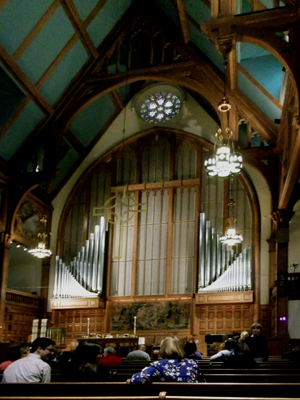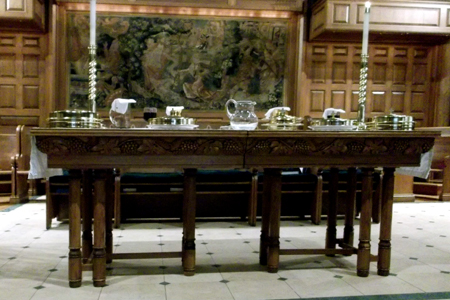| |
 |
 |
 |
| Comment on this report, or find other reports. |
 |
| Our Mystery Worshippers are volunteers who warm church pews for us around the world. If you'd like to become a Mystery Worshipper, start here. |
 |
| Find out how to reproduce this report in your church magazine or website. |
|
|
| 2662: Madison
Avenue Presbyterian, New York City |
 |
 |
 |
Mystery
Worshipper: Paterfamilias.
The church:
Madison Avenue
Presbyterian, New York City.
Denomination:
Presbyterian
Church (USA).
The building:
The present building was designed in 1899 by James E. Ware &
Son, the architectural firm that devised what is known as the
"dumbbell plan" for tenement houses – buildings
that are narrower at the center than at the front and back,
thus providing air shafts to ventilate interior rooms. Ware's
tenements are also known for their facades featuring gargoyles,
terra cotta filigree, and dwarf columns. The church employs
a traditional design: rectangular in shape and with a high vaulted
ceiling. Renovations done in 1961 enlarged the chancel, many
of whose original features were restored during renovations
undertaken again in 1999. Choir pews are behind the communion
table and pulpit. There is an extensive balcony. There is a
beautiful tapestry behind the choir pews.
The church:
The congregation was formed in 1834 and relocated several times,
merging with other Presbyterian congregations, before settling
down under its present incarnation. There is quite a broad range
to the activities of this community, amply described on the
parish website. In their social justice outreach there is a
focus on hunger ministries, a homeless shelter for men jointly
sponsored with St James Episcopal Church (a couple of blocks
away), and ministries for women and children at risk. The parish
sponsors a day school for children. The music program is extensive,
with several choirs, two community choral groups, and a vibrant
concert series. There are three services each Sunday (at 9.00am,
11.15am, and 7.30pm), with holy communion celebrated at each
Sunday service. There are prayer services each Monday through
Friday morning.
The neighborhood:
The church is located on Madison Avenue at East 73rd Street,
in Manhattan's Upper East Side, just a block and a half from
Central Park. The Metropolitan Museum of Art is nearby. Most
of the immediate neighborhood is upscale condominiums and high
end shops and restaurants.
The cast:
The Revd Fred R. Anderson, D.Min., pastor; the Revd Beverly
A. Bartlett, associate pastor for congregation life; the Revd
Donald B. Wahlig, associate pastor for outreach and evangelism;
and the Revd Andrew D. Ruth, global ministry fellow, shared
leadership of the service. All four clergy were vested in black
robe (with ruff) and stole. The pastor preached. Mary W. Huff,
associate director of music, was in charge of the choirs, and
Andrew E. Henderson, A.Mus.D., director of music, presided at
the organ.
The date & time:
Feast of the Transfiguration, March 2, 2014, 11.15am.
What was the name of the service?
Service for the Lord's Day: Word and Sacrament.
How full was the building?
I would guess the lower part of the church (not including the
balcony) seats around 400, perhaps a bit more, and was about
40 per cent full.
Did anyone welcome you personally?
Materfamilias and I were handed a bulletin and greeted with a "Good morning" as we entered. After we took our seat in the pews, a woman handed us an attendance pad to sign.
Was your pew comfortable?
Quite comfortable. No kneelers.
How would you describe the pre-service
atmosphere?
We entered after the organ prelude (John Weaver's Passacaglia
on a Theme of Dunstable) had begun; the atmosphere was
quiet and reverential.
What were the exact opening words of the
service?
"The Lord be with you," to which we responded, "And also with
you." Then: "Welcome on this Feast of the Transfiguration."
At this point, Pastor Anderson realized his mic was not working,
and so he fiddled with it and said, "Let's try that again. The
Lord be with you."
What books did the congregation use during the
service?
The Presbyterian Hymnal (1990) and a tri-fold service
leaflet with the order of service, texts for the versicles and
responses that occurred at various points in the service, and
music for the Kyrie, Gloria in excelsis, Sanctus, memorial acclamation,
and other service music.
What musical instruments
were played?
A pipe organ by Casavant Frères of St Hyacinthe, Québec,
installed in 1961 and modified by various other organ builders
over the years. The instrument was completely reconditioned
in 2011, once again by Casavant Frères. Also, a grand
piano was used to accompany an anthem by the parish's combined
children's choirs.
Did anything distract
you?
Only one thing: the very small type of some of the service music
in the service leaflet. One bit was especially difficult to
read.

Was the worship stiff-upper-lip,
happy clappy, or what?
A formal liturgy with some informal moments. One example of
the latter would be the opening words of the service, noted
earlier. The Revd Andrew D. Ruth introduced the confession of
sin with some informal comments. The peace was enthusiastically
shared (it was placed after the confession and declaration of
pardon, before the liturgy of the Word). There was a full eucharistic
prayer, somewhat different in content from what I am used to
from Lutheran and Anglican services: dialogue, preface, recounting
of salvation history, then the intercessions for the day, followed
by a strong epiclesis (described in the bulletin as the "Prayer
of Consecration" – Eastern Rite Presbyterianism?)
and the doxology. This prayer was led alternately by all four
ministers. The institution narrative was read at the fraction.
Exactly how long was the
sermon?
17 minutes.
On a scale of 1-10, how
good was the preacher?
9 – The pastor is a very accomplished public speaker who
clearly held his congregation's attention in spite of a very
scholarly approach: no comparisons to contemporary events, no
jokes.
In a nutshell, what was
the sermon about?
There was a children's sermon between the sung metrical psalm
and epistle. It was actually a dialogue between the pastor and
the children, in which he asked them about the word "glory."
After listening to several of their attempts at a definition,
he told them that glory was "God being present in a very special
way." He and the children then prayed an "echo prayer." The
adult sermon was a quite scholarly commentary on the gospel
for the day, Matthew 17:1-9 (the Transfiguration). He noted
that Jesus had six days earlier asked, "Who do people say that
I am?" and then "Who do you say that I am?", leading to Peter's
confession that "You are the Christ." He brought in references
to Moses and Elijah, noting that they were not thought of as
dead, but that they were expected to play a major role in the
Messiah's reign. When the voice from the cloud says, "This is
my Son in whom I am well-pleased; listen to him," God is speaking
directly to us as well as to the disciples. As we come down
from the mountain of epiphany and begin our Lenten discipline,
we must also "listen to him."
Which part of the service was like being in
heaven?
Beautiful choral music and superb preaching are always welcome.
But the most heavenly moment occurred at the end of communion.
The congregation had finished receiving, and the choir began
to process down the side aisles and then up the center aisle
to communion, singing a canon of Taizé (the Jubilate
Deo, but in English). We were literally surrounded with
their wonderful singing.
And which part was like
being in... er... the other place?
My personal prejudice – but I could really go a decade
or so without hearing the Old Hundredth doxology yet again!
What happened when you
hung around after the service looking lost?
I do not often attend Presbyterian services, so I had a couple
of questions, which I presented to parishioners around me. All
four of the clergy were waiting to greet us as we left, and
I had a short conversation with Pastor Anderson. He asked what
brought us to New York, and I mentioned our eleven-month old
grandson, to which he replied, "Then we'll expect to see you
here often."
How would you describe the after-service
coffee?
There was none.
How would you feel about making this church your regular (where 10 = ecstatic, 0 = terminal)?
9 – This Lutheran and his Catholic spouse could be quite at home here. Their commitment to social justice seems to be significant, and the music is exceptional. I say "9" only because there are so many options in New York.

Did the service make you feel glad to be a
Christian?
Absolutely, and pleased that my denomination (ELCA) and the
Presbyterian Church (USA) are full-communion partners.
What one thing will you remember about all this in seven days' time?
The Taizé canon at the end of communion. |
|
|
 |
 |
 |
| We rely on voluntary donations to stay online. If you're a regular visitor to Ship of Fools, please consider supporting us. |
 |
 |
 |
| The Mystery Pilgrim |
 |
| One of our most seasoned reporters makes the Camino pilgrimage to Santiago de Compostela in Spain. Read here. |
 |
 |
 |
| London churches |
 |
| Read reports from 70 London churches, visited by a small army of Mystery Worshippers on one single Sunday. Read here. |
| |
|
|
|
|


